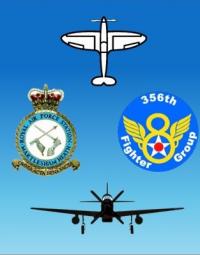

Martlesham Heath Aviation Society
Welcome to Our Website


Welcome to Our Website
356th FIGHTER GROUP USAAF
The 356th Fighter Group of the United States Army Air Force was based here at Martlesham Heath from October 1943 to May 1945.
It was formed in the United States on December 8th 1942 and consisted of three squadrons, the 359th, the 360th and the 361st.
They were despatched to England on the Queen Elizabeth in the autumn of 1943 and were first based at Goxhill in Lincolnshire where they were equipped and received their aircraft. They were Republic Aviation P47 "Thunderbolts". Many of these were flown to England via the northern route. Refuelling in Newfoundland, Greenland, Iceland and Scotland en route.
They then flew to Martlesham Heath in October 1943. Pilots of the 359th Fighter Squadron were billeted at Kesgrave Hall. Pilots of the 360th Fighter squadron were billeted at Playford Hall and pilots of the 361st Fighter squadron were billeted in houses around the aerodrome at Martlesham. For a while the Americans shared the aerodrome with Typhoons of 56 Squadron, RAF.
From October 1943 until early January 1944 the 356th FG were deployed escorting B17's and Liberators on their daylight raids over occupied Europe. Then their role changed to bombing and straffing missions.
In November 1944 the P47's were replaced by the North American P51 "Mustang."
We owe a great debt of gratitude to our American friends. They arrived over here as young men after learning to fly in the wide open and usually clear skies of Georgia only to be faced with our notorious maritime climate, often with thousands of feet of cloud to descend through. It should not be forgotten that these were single seat aircraft. Navigation was crude by today's standards and the Martlesham pilots considered themselves fortunate to be based relatively close to the coast. As many of them said, "we would fly down the North Sea until we found the radar masts at the mouth of the river Deben. Then it was a simple matter to follow the river as far as Woodbridge. Take a left turn and look for nearby Martlesham!"
Armistice was declared on May 7th 1945 and the Americans left for New Jersey in May and the 356th Fighter Group were disbanded on 10 November that year.
 72 Americans lost their lives whilst serving at Martlesham and they are remembered on the war memorial on the Barrack Square at Martlesham. This believed to be the first to be erected in Europe honour of the American dead.
72 Americans lost their lives whilst serving at Martlesham and they are remembered on the war memorial on the Barrack Square at Martlesham. This believed to be the first to be erected in Europe honour of the American dead.
One of the prime movers for the erection of the memorial were Captain Hervey and his wife, who had opened their home in Little Bealings as a field hospital.
The dedication ceremony was on 26th June 1946 and was the first memorial in Europe to honour the American war dead. The guest of honour was the commander of the United States Air Forces in Europe, Major General Idwal H Edwards.
The church of St Michael’s and All Angels now stands in the centre of the old airfield at Martlesham. The church contains the “Roll of Honour.” This book contains the names of all the personnel of the 356th Fighter Group who lost their lives here.
The book was prepared by Captain Hervey who, with his wife, ran a small field hospital in the neighbouring village of Little Bealings for injured airmen. It contains 72 pages. One for every airman killed, together with details of how and where they died.
The book went to the United States after the war but when the new church on the Heath was built it was thought to be a most appropriate place for it to reside.
After considerable effort the Roll Of Honour was found at the Albert F Simpson Historical Research Centre at the Maxwell air base. Alex Kovacs, a retired USAAF colonel and friend of Martlesham Heath Aviation society, who was also based here persuaded the authorities in the U.S. To part with the book and it was returned to England and can be seen in the church.
All of us of the Martlesham Heath Aviation Society remain grateful for all the assistance, both moral and financial, that the American veterans have offered us since we obtained the use of the Control Tower for our museum.